by Rebecca Furer for Teach It
TEACHER'S SNAPSHOT
Topics:
African Americans, Civics, Civil Rights, Law, Politics & Government, Reform Movements, Rights & Responsibilities of Citizens, Voting & Suffrage, Women's Rights
Town:
Statewide
Grade:
Grade 8
Historical Background
Throughout American history, the right to vote has been available to some people and denied to others. Voting rights have been restricted on the basis of age, race, sex, property value, church membership, ability to pay taxes, and literacy, among other factors. In the 19th century, Connecticut women (notably the Smith sisters in Glastonbury), Native Americans (such as Isaac Glasko of Griswold), and African Americans (such as Bias Stanley and William Lanson of New Haven) all petitioned against injustice on the basis of “no taxation without representation,” but none was ever successful. Twice prior to the passage of the 15th Amendment to the United States Constitution, the Connecticut General Assembly approved striking the word “white” from the qualifications of electors in the state Constitution, only to have it voted down by the public (in 1847 and 1865). While two neighboring states—New York and Rhode Island—granted women full or partial voting rights prior to the 19th Amendment to the United States Constitution, Connecticut women were only granted the right to vote in 1920. The story of disenfranchisement—and the eventual expansion of voting rights—is the story of the changing conceptions of freedom and equality in America.
D1: Potential Compelling Question
D1: POTENTIAL SUPPORTING QUESTIONS
- Who had the right to vote at different times in American history?
- What were the arguments in favor of and against expanding the right to vote at different times in American history?
- Why is it important to vote?
D2: TOOL KIT
Things you will need to teach this lesson:
For the Introduction
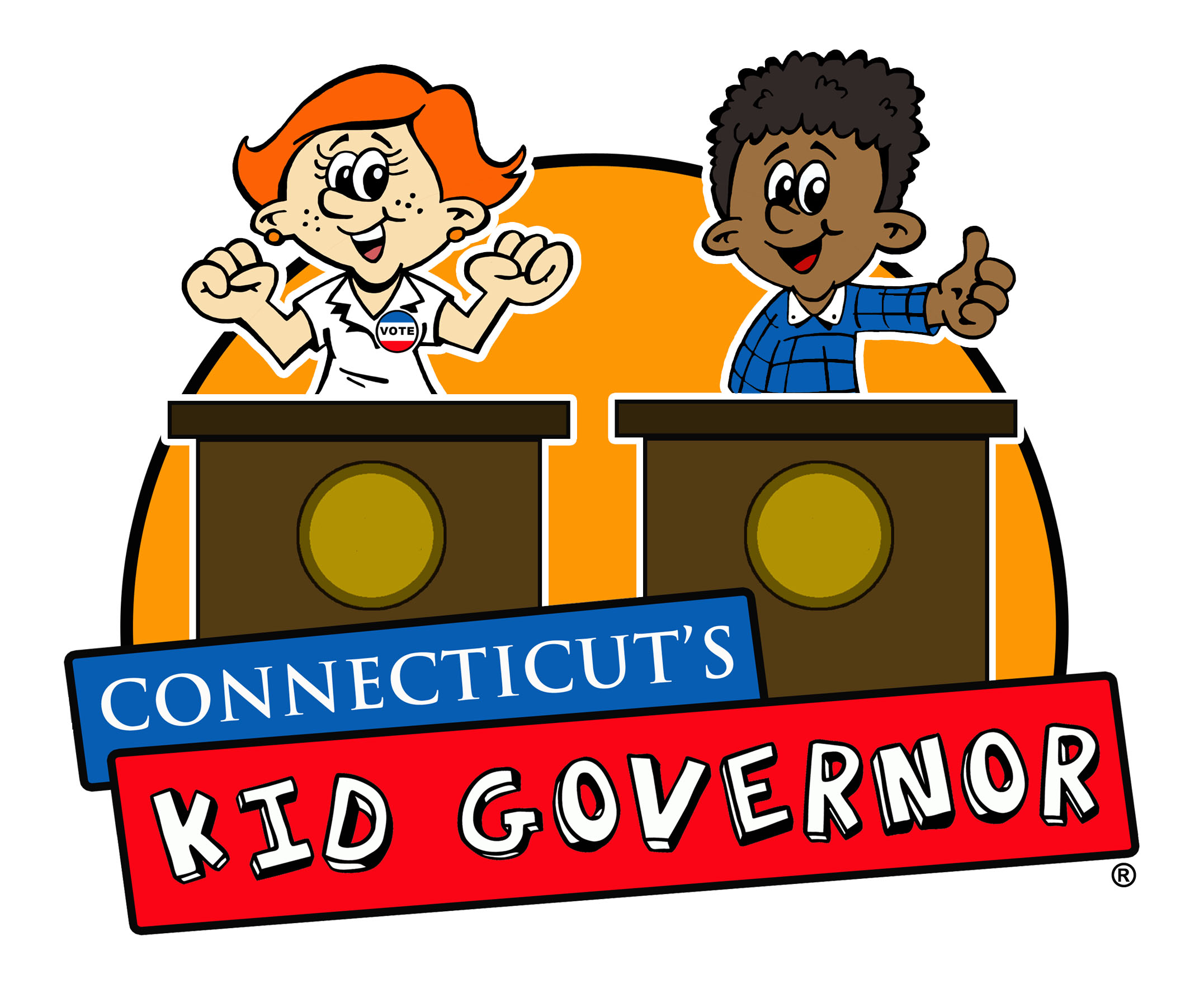
“History of Voting Rights” lesson from the Connecticut’s Kid Governor Toolkit.
Connecticut’s Kid Governor® is a national award-winning statewide civics program created by the Connecticut Public Affairs Network (CPAN).
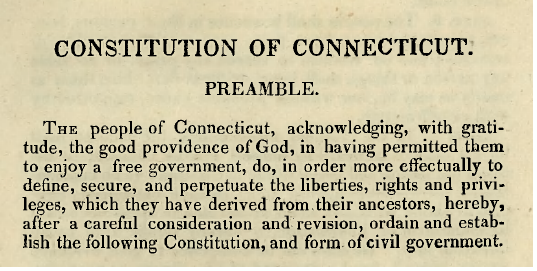
Constitution of Connecticut, 1818. Article VI: Of the Qualifications of Electors – Connecticut State Library Digital Collections.
Note: The original 1818 qualifications were amended several times to add a literacy requirement (1855), addition of “in the English language” to the literacy requirement (1897), and strike out the word “white” (1876). In September 1920, the Connecticut General Assembly passed an act extending voting rights to women, in compliance with the 19th Amendment of the United States Constitution.
For Part 1: African American Suffrage
“Amendment to the Constitution.” Hartford Daily Courant, October 4, 1847. pg 2.
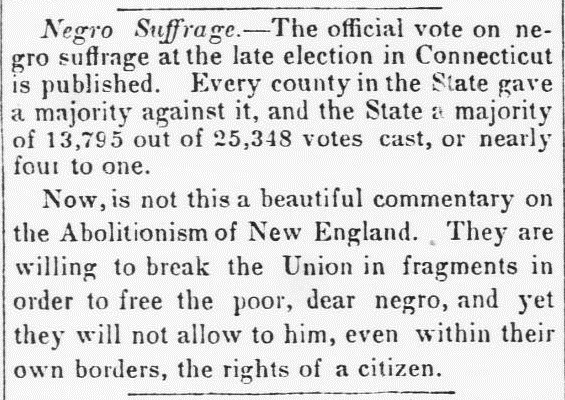
“Negro Suffrage.” Wilmington Journal. (Wilmington, N.C.) November 12, 1847. 3:3 – Chronicling America: Historic American Newspapers. Library of Congress.
“Justice to the Negro.” Hartford Daily Courant, May 26, 1865. pg. 2.
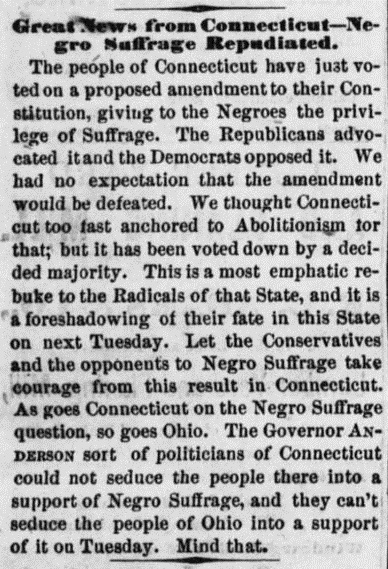
“Great News from Connecticut—Negro Suffrage Repudiated.” Daily Ohio Statesman. (Columbus, Ohio) October 5, 1865. 2:1 – Chronicling America: Historic American Newspapers. Library of Congress.
“The Connecticut Election.” Hartford Daily Courant, October 5, 1865. pg. 3.

“‘All Men Free and Equal.’ The XVth Amendment Proclaimed. Message to Congress.—Proclamation of the President.” J. H. Benham & Son, Printers, New Haven, Conn., 1870. Library of Congress.

Library of Congress Primary Source Analysis Tool Worksheet
For Part 2: Women’s Suffrage
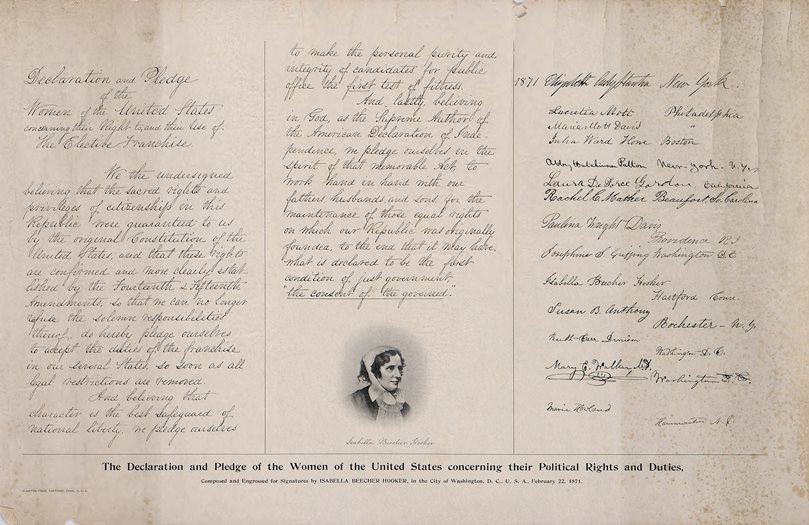
“Declaration and Pledge of the Women of the United States concerning their Right to, and their Use of the Elective Franchise.” Isabella Beecher Hooker, 1871. Connecticut Museum of Culture and History.

Transcription of “Declaration and Pledge of the Women of the United States concerning their Right to, and their Use of the Elective Franchise.” Isabella Beecher Hooker, 1871.

“The Dirty Pool of Politics—Can We Clean It?” postcard. National Museum of American History, Kenneth E. Behring Center, Smithsonian Institution.
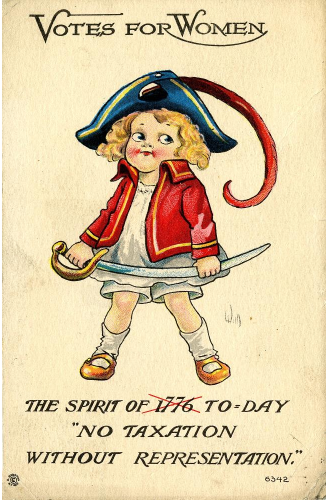
“Votes for Women. ‘No Taxation without Representation’” postcard. National Museum of American History, Kenneth E. Behring Center, Smithsonian Institution.
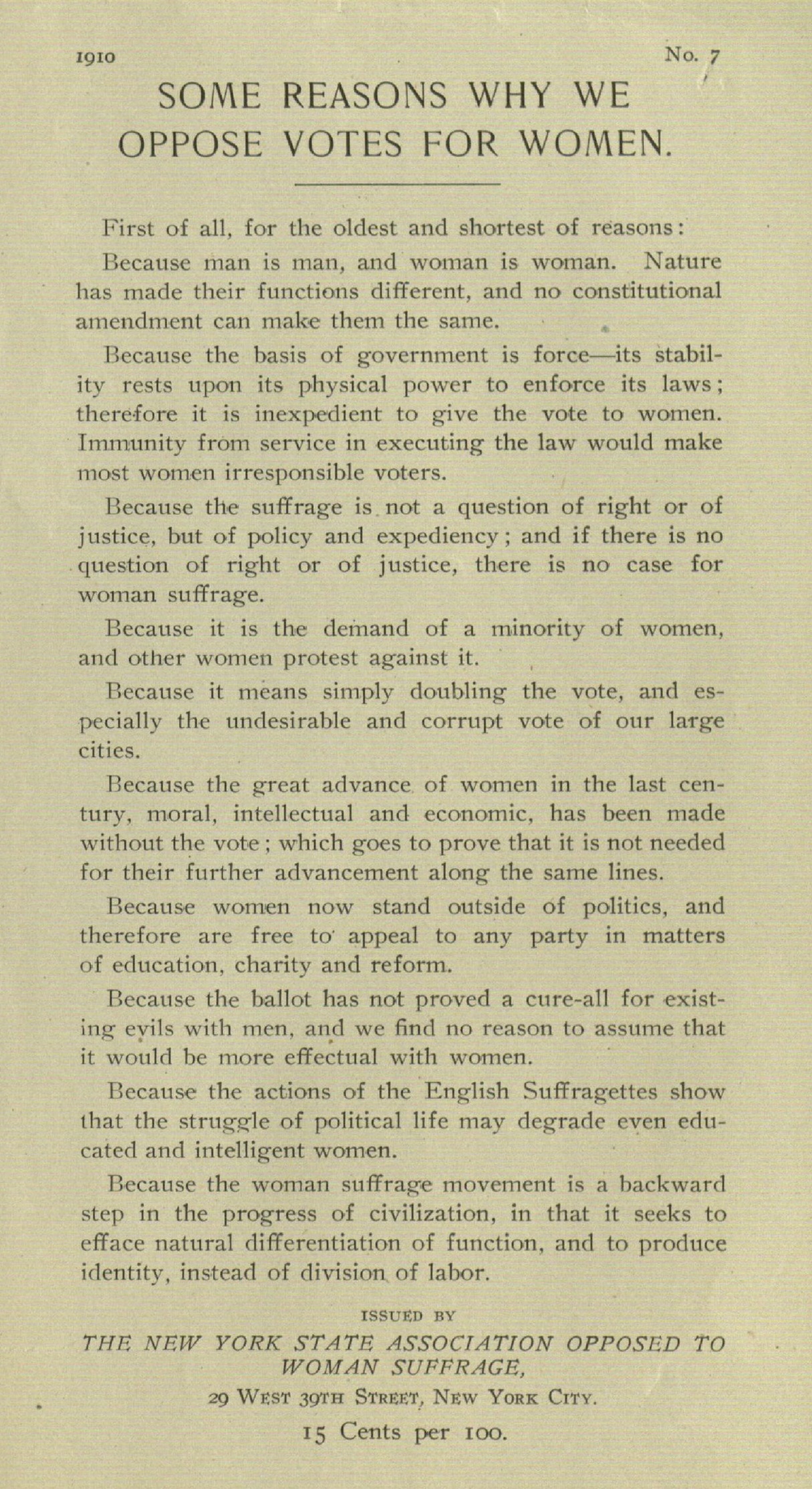
“Some Reasons Why We Oppose Votes for Women.” New York State Association Opposed to Woman Suffrage, 1910. Connecticut Museum of Culture and History.
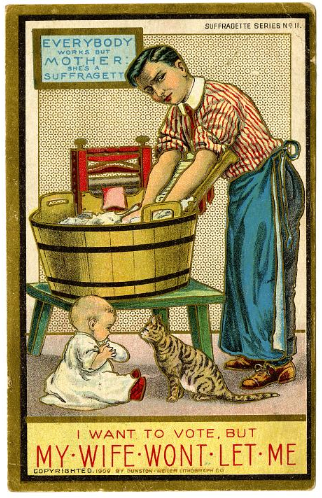
“I want to vote, but my wife won’t let me” postcard. National Museum of American History, Kenneth E. Behring Center, Smithsonian Institution.
D3: INQUIRY ACTIVITY
This is a three-part activity, with an introductory activity, section on African-American voting rights, and a section on women’s voting rights. You may choose to do some or all of the parts.
Introduction
1) Complete the “History of Voting Rights” lesson, from the Connecticut’s Kid Governor® program.
2) Introduce the compelling and initial supporting questions that will guide the inquiry.
3) As a class, examine “Article VI: Of the Qualifications of Electors” from the Connecticut Constitution, 1818.
4) Make a list of the criteria for voting and a list of who/what groups were excluded from voting under Connecticut’s first “official” constitution.
5) Ask students to contribute additional questions that will help guide the inquiry.
Part 1: African American Suffrage
1) Students examine the five newspaper articles, using the analysis technique of your choice. You may wish to use the Library of Congress’s Primary Source Analysis Tool (download Teacher’s Guide), which prompts students to OBSERVE, REFLECT, and QUESTION.
2) Students share their findings and questions in small groups or with the class.
3) Students examine the “All Men Free and Equal” proclamation and discuss the author, subject, intended audience, and purpose of the document.
4) As a class, revisit the supporting and compelling questions and make a list of any remaining questions that could guide further inquiry.
Part 2: Woman Suffrage
1) Working in small groups or individually, half of the students examine sources #1-3 (pro-suffrage); half of the students examine sources #4-5 (anti-suffrage), using the analysis technique of your choice.
2) Students discuss the author (if identifiable), subject, intended audience, historical context, and purpose of each source.
3) Compile a list of arguments made at the time in favor of and against women’s suffrage. Were these arguments the same or different from those that had been made about restricting or expanding the right to vote to different people/groups in the past?
4) As a class, revisit the supporting and compelling questions and make a list of any remaining questions that could guide further inquiry.
D4: COMMUNICATING CONCLUSIONS
- Imagining they are living in Connecticut immediately after the passage of the 15th (1870) or 19th (1920) Amendment to the United States Constitution, students will create a broadside (poster) or newspaper advertisement designed to convince either African Americans or women to vote in the next election. Students should consider and reference the historical context and events that led to the expansion of voting rights to this group.
- Students will create a contemporary “Get out the Vote” campaign (advertisement, PSA, etc.) to inform potential voters about the importance of civic participation.
ADDITIONAL RESOURCES
Place to GO
Things To DO
Check out these mostly satirical poems in response to anti-suffrage arguments: Are Women People? A Book of Rhymes for Suffrage Times by Alice Duer Miller. New York: George H. Doran Company, 1915.
Contact your town’s Registrar of Voters to find out more about voting in your community.
Dig into recent election results, including voter turnout, at the Secretary of the State’s website.
Websites to VISIT
Centuries of Citizenship: A Constitutional Timeline from the National Constitution Center
It’s Your Right – Why Voting Matters from the office of the Connecticut Secretary of the State, Denise W. Merrill
Connecticut Constitutional History from the Connecticut State Library.
Articles to READ
“Voting in Early America” by Ed Crews. The Colonial Williamsburg Journal, Spring 2007.
ConnecticutHistory.org:
- “Blacksmith Isaac Glasko Challenges the State Constitution” by Andy Piascik.
- “The Smith Sisters, Their Cows, and Women’s Rights in Glastonbury” by Molly May.
- “The Smith Sisters and Their Cows Strike a Blow for Equal Rights – Today in History: January 8.”
- “Literacy Tests and the Right To Vote” by Steve Thornton.
CTExplored.org:
- “Our Hard-Won Right to Vote” by Elizabeth Normen. Connecticut Explored, Spring 2016.
- “‘No Taxation without Representation’: Black Voting in Connecticut” by Katherine J. Harris. Connecticut Explored, Spring 2016.
- “The Long Road to Women’s Suffrage in Connecticut” by Jessica D. Jenkins. Connecticut Explored, Spring 2016.



